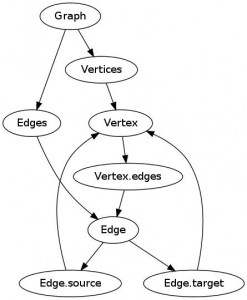rgraphum is the open source for graph and complicated network analysis written by ruby.
Add this line to your application's Gemfile:
gem 'rgraphum'
And then execute:
$ bundle
Or install it yourself as:
$ gem install rgraphum
rgraphum is framework and a console application for analysis of graph and complex network. It is made of ruby, you can accept the code of ruby. Now, let’s see while using the console application an overview.
start console application
$ rgraphum_console
By creating an instance of the Graph class, rgraphum will have the entity graph. graph = Graph.new Instance of Graph will have an instance of Vertices and an instance of the Edges, such as Array. graph.vertices graph.edges (An array of empty initial both)
When adding vertex or edge, it is operation on vertices, edges, and vertex.edges. vertex or edge is specified in an instance such as the Hash.
v_a = graph.vertices.build(label:"A")
v_b = graph.vertices.build(label:"B")
graph.edges.build(source:v_a,target:v_b)
v_a.edges.build(source:v_b,target:v_a)
vertex will have edges being like a Array. edge in the edges refers to the object. This is the same as the one in the edges of the graph.
v_a.edges
e_a_b = v_a.edges[0]
graph.edges
graph.edges[0].object_id
e_a_b.object_id
edge has a target and source, these are objects of vertex. This is the same as the one in the graph.vertices.
s_v= e_a_b.source
t_v = e_a_b.target
s_v.object_id
t_v.object_id
graph.vertices[0].object_id
graph.vertices[1].object_id
search is done in graph.vertices, graph.edges, and vertex.edges.
v_a = graph.vertices.where(label:"A").first
v_a = graph.vertices.where(label:"A")[0]
e_a_b = graph.edges.where(source:v_a).first
e_a_b = v_a.edges.where(source:v_a).first
Delete as well, do in graph.vertices, graph.edges, and vertex.edges.
graph.edges
v_a.edges
e_b_a = v_a.edges[1]
v_a.delete(e_b_a)
v_a.edges
graph.edges
v_a.edges
e_a_b = v_a.edges[0]
graph.edges.delete(e_a_b)
v_a.edges
graph.vertices
graph.vertices.delete(v_a)
graph.vertices
As a sample, The graph above, on the console, was made the following script.
graph = Graph.new
v_g = graph.vertices.build(label:"Graph")
v_vs = graph.vertices.build(label:"Vertices")
v_es = graph.vertices.build(label:"Edges")
graph.edges.build(source:v_g,target:v_vs)
graph.edges.build(source:v_g,target:v_es)
v_v = graph.vertices.build(label:"Vertex")
v_e = graph.vertices.build(label:"Edge")
graph.edges.build(source:v_vs,target:v_v)
graph.edges.build(source:v_es,target:v_e)
v_v_es = graph.vertices.build(label:"Vertex.edges")
graph.edges.build(source:v_v,target:v_v_es)
graph.edges.build(source:v_v_es,target:v_e)
v_e_s = graph.vertices.build(label:"Edge.source")
v_e_t = graph.vertices.build(label:"Edge.target")
graph.edges.build(source:v_e,target:v_e_s)
graph.edges.build(source:v_e,target:v_e_t)
graph.edges.build(source:v_e_s,target:v_v)
graph.edges.build(source:v_e_t,target:v_v)
Parsers::GraphvizParser.export(graph,"graph_struct","jpg")
- Fork it
- Create your feature branch (
git checkout -b my-new-feature) - Commit your changes (
git commit -am 'Add some feature') - Push to the branch (
git push origin my-new-feature) - Create new Pull Request
